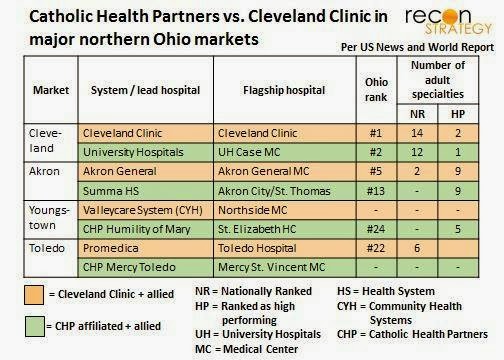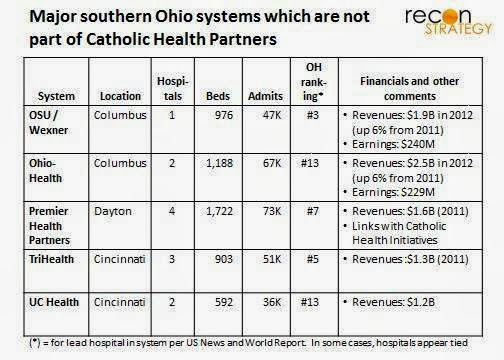Summary
- In August and early September, several Ohio provider systems have picked sides in the competition between Catholic Health Partners and Cleveland Clinic
- The recently announced Health Innovations Ohio collaboration signals that Catholic Health Partners is playing for the overall Ohio market; however, there is no clear, attractive competitive response for Cleveland Clinic
- Cleveland Clinic lacks a footprint in populous southern Ohio to match Catholic Health Partners but it is not obvious which systems there would seek an alliance or an acquisition
- Cleveland Clinic and Community Health Systems joint venture has quickly evolved changed form a clinical collaboration to an M&A vehicle
Recently, there was a big announcement regarding a partnership among four Ohio provider systems: Catholic Health Partners (CHP), University Hospitals (UH), Summa and Mt. Carmel Health System. The collaboration, dubbed Health Innovations Ohio, “…will transform healthcare across the state by fostering value-based care and payment reform throughout the founding members’ health systems.” Curiously, given the fanfare of the announcement, the collaboration is not new. In fact, it has been going for a year already with a former hospital CEO at its helm. Nor was its public announcement tied with any major milestone or new set of programs. This sounds like a case of strategic signaling. But, if so, what is the message and who are its intended recipients? I would argue that the announcement is another step in an on-going competitive battle between CHP and the Cleveland Clinic (CC).
Context
CHP and CC are currently locked in a competitive “system grab” in northern Ohio. To briefly recap: CHP, the largest provider system in Ohio, got the ball rolling with acquisitions earlier this year: In February, CHP bought a 30% share in Summa Health System which operates in Akron, just south of CC’s home turf. And, in May, CHP acquired the Kaiser Permanente (KP) health plan and option to acquire the KP docs which operated largely in the Cleveland and Akron areas.
CC then countered with two of its own: On August 8, it announced the conversion of its innovation alliance with Promedica (a major health system which competed with CHP’s Mercy subsidiary in the Toledo area) into an affiliation. And then, on August 22, CC together with its for-profit, publicly-held joint venture partner, Community Health Systems (CYH), announced plans to acquire Akron General, the #5 rated hospital system in Ohio and a key competitor to Summa in Akron.
As a result of these four moves, CHP moved into CC’s home terrain and CC has expanded its market overlap with CHP in northern Ohio (note: CHP is also very strong in southeast Ohio where CC has little involvement). Then, a little more than a week after the CC-CYH-Akron General deal, CHP (and its three partners) decided to publicize the Health Innovations Ohio partnership.
What is Health Innovations Ohio (HIO)?
The partners describe HIO as a vehicle for coordination and best practice sharing (right now through ten teams made of members from each of the four partners and working on population health, Medicare Advantage and Medicaid). It is governed collaboratively and equally across the four partners. It is not (per the publicized FAQ’s) a merger or affiliation among the four.
The partnership has declared three areas of focus:
- Collaboration across the four systems on networks for Medicare Advantage plans of Summa and Mt. Carmel;
- Working with Medicaid plans to introduce accountable care for Medicaid (care coordination coupled with pay for performance and shared savings);
- Identification of best practices for population health management and roll these out systematically across the employees and dependents of the four systems.
At first, I found it puzzling that HIO was announced now and who the audience for the announcement was. The first objective is old news: MA network deals were already in place for the 2013 effective year already (and, by the way, the Mt. Carmel and Summa plans gained a lot of lives perhaps as a result). As for Medicaid, surely the 2014 contracts are completed and the big Medicaid plans (there are basically three, maybe six, which matter) are certainly already aware of how the four providers want to approach Medicaid already (rather than learning by press release). And, similarly, regarding population health approaches, the TPAs and vendors being used by the four partners to manage the care of their employees presumably are already active partners in these endeavors. Given that the collaboration has been going on a year, why announce now with no obvious immediate business goal to exploit the publicity?
Strategic signaling
Here are a few hypotheses on the strategic signaling value of the announcement:
Locking University Hospitals into the CHP orbit. University Hospitals is the #2 system in Ohio (behind CC) and the major competitor to CC in Cleveland. By publicizing the University Hospitals connection with HIO, CHP is signaling that CC is the target of its northeast Ohio maneuvers and, likely, the referral and facilities-based care coming out of CHP’s Kaiser acquisition will flow to University Hospitals. In fact, University Hospitals strong clinical ranking adds credibility to the CHP orbit more generally, given that Cleveland Clinic affiliated systems rank better in most overlapping markets (exception: Youngstown).
Reassuring Summa regarding its choice of partner. CC’s purchase of Akron General intensifies the competitive threat to Summa in the Akron market. Akron General has historically had uneven finances and leadership changes but, as the #5 system in Ohio, it has also had a better ranking in terms of quality and outcomes than Summa (the #13 system). Given the acquisition, Akron General can expect to have more consistent leadership, access to CYH operational capabilities and clinical backing from CC. For Summa stakeholders, therefore, HIO announcement confirmed the size, scope and resources of its new partial owner (University Hospitals and Mt. Carmel bring nearly 2,000 beds into the emerging alliance) and also signaled a clear strategic commitment by CHP to compete on the basis of accountable care.
Signaling future entrants on the Ohio Exchange. For 2014, CHP’s products for the Exchange (under the HealthSpan brand) are focused on CHP service areas. The HIO providers, however, have most of the major population centers covered (with University Hospitals and Mt. Carmel filling in CHP/Summa gaps in Cleveland and Columbus). If HIO builds greater network and care coordination collaboration, they could offer an Ohio wide set of products leveraging vertical payer/provider economics in the major population areas. In addition, the focus on making accountable care work in Medicaid will have fruits among the subsidized Exchange population which shares much of the demographics and some of the health issues of the core Medicaid population. The HIO announcement, therefore, could change the calculus of players who sat out the Ohio exchange 2014 but might have been considering participation in 2015 (United – the #2 plan in Ohio, and Aetna, which very visibly opted out in 2014 in August): their estimates of the size of the Exchange prize for 2015 might have gotten small enough and uncertain enough to stay out for another year at least.
Employers should watch this space. The collaboration on employer-based population management strategies seems like a longer-term signal to the market. The 2015 selling season for large employers will begin soon. Unless HIO can announce a series of completed pilots and productized results over the coming months, this will likely be an opportunity for 2016 at the earliest. In the meantime, it may make for an interesting point in HealthSpan marketing (HealthSpan is CHP’s subsidiary selling care and network management services) but not much more.
Speculations on Cleveland Clinic’s next move: wait and see?
The HIO announcement provides further evidence that CHP is planning on competing with CC on the basis of system value (including all the way through to providing insurance). There are some hints that CHP may focus more on the “down market” (Medicaid and Exchange”) but my guess would be that CHP’s relationship with University Hospitals is too much of a threat to CC for such a subtle signal to be trusted.
There are a couple ways CC could respond:
- Affiliate with some major southern Ohio systems to competitively threaten CHP’s “home turf”;
- Accelerate its move into insurance to protect its access to patients (either by bulking up on Promedica or strengthening ties with Med Mutual or other major Ohio insurers on joint narrow network products).
Neither move nor a combination of the two is obviously easy or correct at this point. The southern Ohio systems in Columbus and Cincinnati are powerful and proud (see exhibit). It is hard to see any of them being willing to affiliate on CC terms until CHP starts taking a bigger bite out of their economics and that will take time (note that CHP was flexible in its approach to Summa taking a 30% share only; CC seems to draw firmer lines between clinical collaboration and business affiliation).
The key challenge with an insurance play will be cannibalization. CC’s brand strength no doubt allows them to command attractive rates. But competing for the “down market” segments (Medicaid, exchanges, small group) will require very attractively priced products. Typically, the economic strategy behind narrow network/clinically progressive products is to start with deep discounts, then earn them back over time as clinical strategies kick-in. Given that CHP’s rates (and those of its HIO partners) are probably lower than CC, they will need less of an upfront discount to make an attractive product. For CC, however, the cost of those discounts may just not make the play worthwhile. (Not to mention Cosgrove’s pessimistic view about the insurance business: why invest in stranded assets if we are headed to single payer?)
My take, then, is that the CC will wait and see before making another major move in Ohio. If Exchanges take off, if employers opt-out, if CHP is able to convert HIO into a strategic alliance, CC has access to the insurance assets (through Promedica or by deepening the relationship with Med Mutual) and the potential southern Ohio partners to replicate CHP’s approach. Along these lines, no surprise then that CC’s latest move is not in Ohio as all but striking a deal to buy MetroHealth in Grand Rapids, Michigan.


